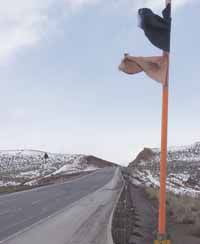| Marker flags whip in the wind on a three-lane section of U.S. Highway 6 near Colton. UDOT has released a supplemental draft environmental impact statement indicating the three-lane system will have to be built on about 12 miles of the U.S. 6 corridor between Spanish Fork and Green River due to wetland concerns. |
The Utah Department of Transportation has released a supplement to the state agency’s draft environmental impact statement on the U.S. Highway 6 corridor.
Carbon County residents will have an opportunity to comment about the new aspects of the plan when the state agency conducts an open house public hearing on March 8 at College of Eastern Utah .
The supplemental draft environmental impact statement will analyze additional information that has surfaced involving in the four-lane alternative, according to the state transportation department.
Issues to be addressed in connection with the supplemental draft environmental impact statement include air quality standards, water quality concerns and wetlands areas with wetlands associate, explained the transportation agency.
The original draft environmental impact statement regarding the proposed highway improvement projects was presented to the public several months ago.
The initial draft DEIS document focused on safety and projected how the U.S. 6 corridor may best handle traffic through the year 2030.
But since the original release of the DEIS, new information has come to light that UDOT needed to consider before setting permanent plans for the highway improvement projects in the U.S. 6 corridor, noted transportation officials.
UDOT reminded residents that the state agency is still analyzing input from prior meetings and the comments do not need to be resubmitted at the March 8 open house.
After the latest comments are considered, UDOT plans to release a final environmental impact statement during the summer.
The new specific areas UDOT will examine include:
•Minimizing impacts to wetlands on about 12 miles of the 127-mile four-lane route.
UDOT has determined that cutting the road to three lanes, with a passing lane in one direction., would reduce impacts to wetlands.
The wetlands information is included in the supplemental draft environmental impact statement released by transportation department.
•Because of concerns about air quality and emissions of particulate matter, a study was done on a similar highway with heavier traffic volume to examine potential impacts.
The results of the study indicated that the lower volume of traffic on a revamped U.S. Highway 6 would not exceed the permitted particulate emission levels.
•Reviewing concerns that adding pavement along the route would increase pollutants in the Price River.
The department of transportation revamped the water quality analysis to determine whether the extra runoff into Price River would exceed the daily accepted load of pollutants.
The study showed that the additional road surface would not impact the drainage.
The former meetings have also created some direction for UDOT already. First of all it seemed the support in comments for widening the highway to four lanes was overwhelming.
Secondly, the highest priority area on the highway as determined by public comment was improving the Tucker Rest Area Corner. Close behind in second place was the Red Narrows area, where the alternatives to fixing the curve problems there either means straightening out the curves by taking out whole hillsides or building tunnels through the mountains. Both those alternatives would make this short section of highway by far the most expensive section of the road to revamp.
Finally the plan does not appear to consider any additional widening of the road through Wellington until after the second decade of the present century.

